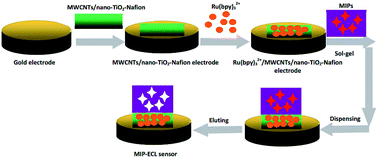A novel molecularly imprinted electrochemiluminescence sensor based on a Ru(bpy)32+/MWCNTs/nano-TiO2-Nafion electrode for the detection of bisphenol A
Abstract
A novel molecularly imprinted electrochemiluminescence sensor based on a Ru(bpy)32+/multi-walled carbon nanotubes (MWCNTs)/nano-titanium dioxide (nano-TiO2)-Nafion electrode was established for the ultrasensitive and ultraselective detection of bisphenol A (BPA). The introduction of MWCNTs/nano-TiO2 nanohybrids into the Nafion film could provide an excellent basis for effective immobilization of Ru(bpy)32+ and improve the electrochemical and ECL properties of Ru(bpy)32+. The MIP-ECL sensor fabricated by the combination of the MIT with the Ru(bpy)32+ ECL system could provide specific binding sites for BPA and the selectivity of the sensor was significantly improved. Under the best optimum conditions, the proposed MIP-ECL sensor not only exhibited high sensitivity and selectivity for BPA, but also displayed acceptable reproducibility and stability. A linear range from 0.01 μg L−1 to 2 μg L−1 for the detection of BPA was observed with a detection limit of 0.0041 μg L−1. Moreover, the fabricated sensor was successfully used to detect BPA in ambient water samples and relatively satisfactory recoveries were obtained.


 Please wait while we load your content...
Please wait while we load your content...